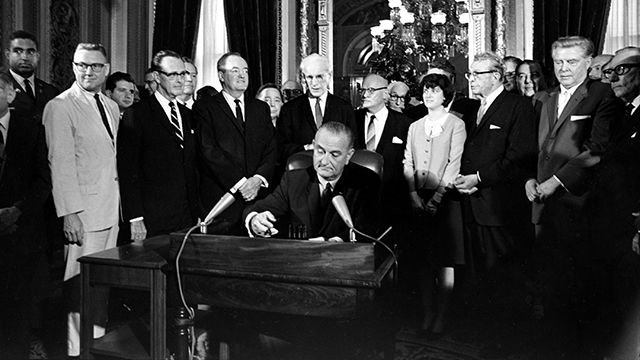This post first appeared in The Nation.

“Today is a triumph for freedom as huge as any victory that has ever been won on any battlefield,” President Lyndon Johnson said on August 6, 1965, when he signed the Voting Rights Act into law.
The VRA quickly became known as the most important piece of modern civil rights legislation and one of the most consequential laws ever passed by Congress. It led to the abolition of literacy tests and poll taxes; made possible the registration of millions of minority voters; forced states with a history of voting discrimination to clear electoral changes with the federal government to prevent future discrimination; and laid the foundation for generations of minority elected officials.
Inside the U.S. Capitol Rotunda, LBJ announced the signing of the bill flanked by a bust of President Lincoln, who exactly 104 years earlier had signed the Confiscation Act freeing Confederate slaves. Among the many civil rights leaders present on that historic day forty-eight years ago was John Lewis, the 25-year-old chairman of the Student Nonviolent Coordinating Committee, who had nearly died four months earlier marching for the right to vote in Selma, Alabama. Lewis was the only veteran of the “Bloody Sunday” march to attend the signing ceremony. He remembered that day in August 1965 as “a high point in modern American, probably the nation’s finest hour in terms of civil rights.”
Twenty-one years later, Lewis won election to Congress from Georgia’s 5th House district, representing the hometown of his idol Martin Luther King Jr. He has the pen LBJ gave him after signing the VRA framed in his Atlanta home and a bust of the 36th president in his Washington office. Without the VRA, there would be no Congressman Lewis or Senator Rubio or President Obama. “When Lyndon Johnson signed the Voting Rights Act,” Lewis said on a trip to Alabama in March, “he helped free and liberate all of us.”
Consider how the VRA transformed American democracy:
-In 1965, only 31 percent of eligible black voters were registered to vote the in the seven Southern states originally covered by the VRA, compared to 72 percent of white voters. The number of black registered voters was as low as 6.7 percent in Mississippi. In Selma, only 393 of 15,000 eligible black voters were registered when LBJ introduced the VRA in March 1965.
Today, 73 percent of black voters are registered to vote according to the U.S. Census and black voter turnout exceeded white turnout in 2012 for the first time in recorded history.
-In 1965, there were fewer than 500 black elected officials nationwide. Today, there are more than 10,500.
-In 1965, there were only five black members of Congress. Today there are 44. The 113thCongress is the most diverse in history, with 97 minority elected representatives.
-Since 1965, the Justice Department blocked at least 1,150 discriminatory voting changes from going into effect under Section 5 of the VRA.
Yet the Supreme Court’s decision in late June invalidating Section 4 of the VRA threatens to roll back much of the progress made over the past 48 years. Since the ruling, six Southern states previously covered under Section 4 have passed or implemented new voting restrictions, with North Carolina recently passing the country’s worst voter suppression law. The latest assault on the franchise comes on the heels of a presidential election in which voter suppression attempts played a starring role, with 180 bills introduced in 41 states to restrict access to the ballot in 2011-2012, which NAACP President Ben Jealous called “the greatest attacks on voting rights since segregation.” The broad scope of contemporary voting discrimination is why John Lewis testified before Congress last month that “the Voting Rights Act is needed now like never before.”
The spread of voter suppression efforts to states like Pennsylvania, where over 500,000 registered voters could be disenfranchised by a voter ID law before the courts, is a strong argument for expanding, not eliminating, the key provisions of the VRA. Sections 2 and 3 of the VRA, as currently written, are no substitute for Sections 4 and 5. Under Section 2, discriminatory voting changes can only be challenged after lengthy and expensive litigation, with the burden of proof on those facing discrimination. Under Section 3, a court has to find that a state (like Texas) was guilty of intentional discrimination, a very high bar to clear, in order to force it to approve its voting changes with the federal government for a period of time. Under Section 5, however, the states with the worst history of discrimination had to prove that their voting changes were not discriminatory before they became law. As Chief Justice Earl Warren wrote in 1966, the genius of the law was to “shift the advantage of time and inertia from the perpetrators of the evil to its victims.”
The evil of voting discrimination remains all-too-common today, which is why Congress urgently needs to strengthen the VRA. Rep. James Sensenbrenner (R-Wis.), the former chair of the House Judiciary Committee who presided over the overwhelming Congressional reauthorization of the VRA in 2006, recently told Congressional Quarterly, “there are a lot of Republicans who are [on board], but they don’t want to be publicly named.” If there is indeed a silent majority of Republicans who still support the VRA, let’s hope they speak up soon. Otherwise, on the 50thanniversary of the VRA in 2015, we may be mourning its demise instead of celebrating its transformational impact.
 |
Ari Berman is a contributing writer for The Nation magazine and an Investigative Journalism Fellow at The Nation Institute. His first book, Herding Donkeys: The Fight to Rebuild the Democratic Party and Reshape American Politics, was published in October 2010 by Farrar, Straus, and Giroux. He is now working on a history of voting rights since 1965. |

